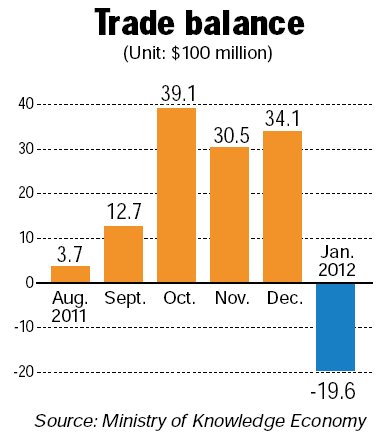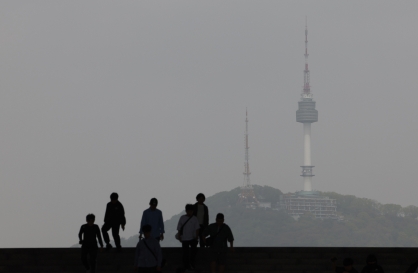Korea’s trade balance swung into the red for the first time in two years in January as the Lunar New Year holiday reduced the shipment volume and the eurozone fiscal crisis dented exports.
The country logged a trade deficit of $1.96 billion last month, compared with a surplus of $2.9 billion a year earlier, the Ministry of Knowledge Economy data showed Wednesday.
Exports unexpectedly fell 6.6 percent on-year to $41.54 billion in January, marking the first contraction in 27 months on a year-on-year basis. Imports rose 3.6 percent to $43.49 billion.

For export-sensitive Korea, the latest numbers came as a worrying sign at a time when the country’s economy is beset by a host of negative factors including the eurozone debt crisis.
Europe’s failure in controlling its messy sovereign debt problem dealt a blow to Korea’s export drive in January.
While overseas shipments to Japan, the U.S. and China all rose, exports to Europe plunged 44.8 percent Jan. 1-20.
Given that Europe has a long way to go before fixing its protracted debt woes, the slow demand for Korean goods from the troubled region is expected to continue for now.
An increase in oil prices also added to the trade deficit last month, amid heightened instability in the Middle East.
The ministry said exports would likely rebound this month, led by key items such as cars and semiconductors. February also has more working days this year, which will bolster the trade balance, it said.
The government projects that country’s exports will go up 6.7 percent to $595 billion this year with imports rising 8.7 percent to $570 billion. The 2012 surplus goal is set at $25 billion.
The road ahead, however, is expected to be rocky, as the eurozone problem drags on and a global economic slowdown threatens Korea’s exports.
While the Bank of Korea forecast 3.7 percent growth this year, data on gross domestic product and industrial output suggests Asia’s fourth-largest economy faces slowing growth and lackluster domestic demand.
By Yang Sung-jin (insight@heraldcorp.com)
The country logged a trade deficit of $1.96 billion last month, compared with a surplus of $2.9 billion a year earlier, the Ministry of Knowledge Economy data showed Wednesday.
Exports unexpectedly fell 6.6 percent on-year to $41.54 billion in January, marking the first contraction in 27 months on a year-on-year basis. Imports rose 3.6 percent to $43.49 billion.

For export-sensitive Korea, the latest numbers came as a worrying sign at a time when the country’s economy is beset by a host of negative factors including the eurozone debt crisis.
Europe’s failure in controlling its messy sovereign debt problem dealt a blow to Korea’s export drive in January.
While overseas shipments to Japan, the U.S. and China all rose, exports to Europe plunged 44.8 percent Jan. 1-20.
Given that Europe has a long way to go before fixing its protracted debt woes, the slow demand for Korean goods from the troubled region is expected to continue for now.
An increase in oil prices also added to the trade deficit last month, amid heightened instability in the Middle East.
The ministry said exports would likely rebound this month, led by key items such as cars and semiconductors. February also has more working days this year, which will bolster the trade balance, it said.
The government projects that country’s exports will go up 6.7 percent to $595 billion this year with imports rising 8.7 percent to $570 billion. The 2012 surplus goal is set at $25 billion.
The road ahead, however, is expected to be rocky, as the eurozone problem drags on and a global economic slowdown threatens Korea’s exports.
While the Bank of Korea forecast 3.7 percent growth this year, data on gross domestic product and industrial output suggests Asia’s fourth-largest economy faces slowing growth and lackluster domestic demand.
By Yang Sung-jin (insight@heraldcorp.com)
-
Articles by Korea Herald



![[AtoZ Korean Mind] Does your job define who you are? Should it?](http://res.heraldm.com/phpwas/restmb_idxmake.php?idx=644&simg=/content/image/2024/05/06/20240506050099_0.jpg&u=)















![[K-pop's dilemma] Is Hybe-Ador conflict a case of growing pains?](http://res.heraldm.com/phpwas/restmb_idxmake.php?idx=642&simg=/content/image/2024/05/07/20240507050746_0.jpg&u=)